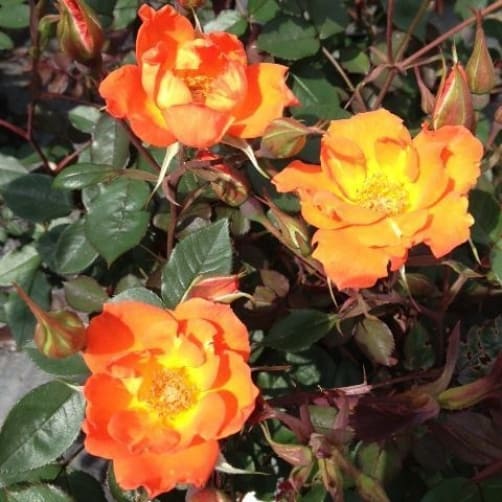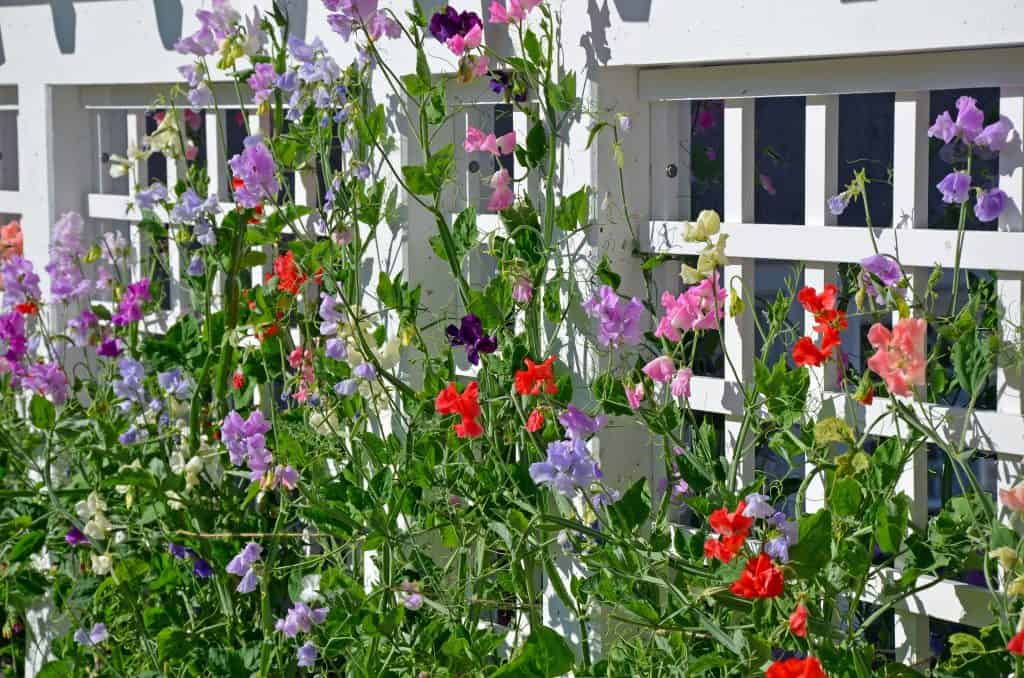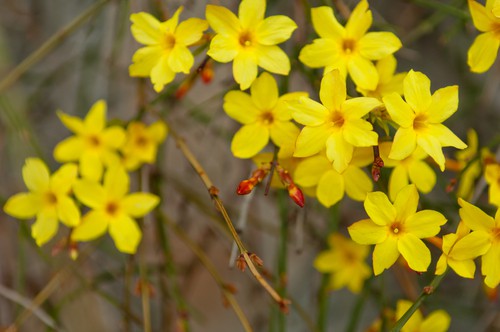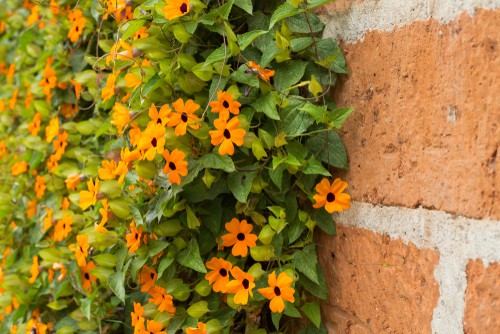Last updated on March 6th, 2022
Our site is reader supported, this means we may earn a small commission from Amazon and other affiliates when you buy through links on our site.
If you are looking for the best climbers for containers, you want plants that are easy to grow, will thrive in pots, do well with a combination of partial shade and full sun (so that you can effectively plant them anywhere) and you can watch as the blooms unfold before your eyes.
Each of these climbers mentioned below will bring beautiful blooms to your garden, bloom prolifically and climb up any structures nearby, offering a beautiful richness and geometry to your garden, especially if you have things like trellises, pergolas or fences that appear dull to the eye.
All of these top ten climbers will thrive in any size pot but in general, the deeper container the better, they require very little maintenance and can bring ambience and aroma to your garden.
1. Clematis

Clematis are climbers that are unsurpassed in terms of their flowering length and the diversity of shapes that they offer. These are perfect for smaller gardens because there are varieties designed specifically for growing in pots. You can find a variety that grows and produces flowers for almost any month of the year. Some types, for example, the clematis montana, only flower in spring, they require very little maintenance and almost no pruning.
There are over 300 species and hybrids so you will not be short of options to choose from. They are terrific for planting in pots or containers, especially if you train them up a small trellis. These compact plants will produce magnificent flowers that take on beautiful pink and purple shades, some of which even have stripes running up the perimeter of each petal or a beautiful design along the perimeter.
We recently looked at some of the best clematises for shade and you can read about them here.
- Characteristics: Gorgeous flowers for gardens, large (12 - 20cm) rose-pink flowers, flourishes thrice year round.
- Growth & Spread: Height 2.4m - 3m, Spread 0.9m - 1.2m.
- Period of Interest: Late Spring - Early Autumn (March - October).
- Plant Advice: Plant them in medium drained soil such as chalk or loam. Clematis plants prefer head in the sun and feet in the shade. Average watering until well established - then just regularly to keep moist. Be sure to prune and shape the shrubs once necessary.
- DICIDUOUS GARDEN SHRUB: The climbing clematis plant produces large, star-shaped blooms with deep violet-blue petals that contrast beautifully against its glossy dark green foliage. Blooms from late spring into summer, with a second flush of flowers in late summer.
- BLOOMING PERIODS: Blooms from late spring into summer, with a second flush of flowers in late summer. These captivating blooms contrast beautifully with the glossy, dark green foliage, creating a beautiful garden display.
- GROWTH AND SPREAD: This outdoor shrub arrives at a manageable height, including the pot, making it ideal for immediate planting. With proper care, it can reach a mature height of 1–2 m and a spread of 0.5 –1 m.
- EASY TO CARE: This garden shrub requires regular watering in the first few seasons to keep the soil evenly moist but not waterlogged. Once developed, this low-maintenance climber becomes drought-tolerant and only needs watering during extended dry periods.
- VERSATILE PLANTING OPTIONS: The hardy, deciduous climber live plant thrives in well-drained soil and prefers full sun to partial shade. Perfect for beginners and seasoned gardeners alike. Its adaptability allows it to be used in various garden settings, such as garden borders, patios, balconies, and urban spaces.
- Clematis Montana - The Mountain Clebe "Rubens" (Clematis Montana Var.) belongs to the family of Ranunculaceae.
- Pink flower: this climbing plant can grow up to 4-5 m high. The Clematis has pink flowers with yellow dust threads and blooms of approx. May to June.
- Climbing plant – the Clematis is a real climbing plant. Let the plant grow on a wall, fence or along a pergola. Help the Clematis climb a little by tying young branches.
- Care – The forest cleb likes a sunny location with humus-rich and moist soil. Add water in dry periods. They keep the foot cool and moist by planting a low shrub in front of your clematis. Also a mulch layer of compost mixed with garden fertiliser encourages growth.
- High quality – At Bakker, we help you to make your home and garden, terrace and balcony green. For over 70 years, our customers have trusted in the excellent quality of our extensive range of plant products. This makes Bakker number 1 in the shipment of plants in Europe
2. Climbing Roses

The beautiful ‘Warm Welcome’ is an award-winning miniature climber that flowers continuously throughout its blooming season. The Warm Welcome rose produces semi-double blooms that take on a bright orange colour, displaying hints of gold at the base. These sprays of flowers are slightly fragrant as well and are developed on red or purple coloured stems which allow them to stand out in contrast to the otherwise dark green leaves. You can plant most climbing roses in pots as long as it’s fairly large and deep.
This is the perfect patio climber for smaller gardens because it’s a miniature climber, very disease resistant and accepting of container growth. If you put it in your border or against a wall it will grow over it and reach heights of 180cm and a width of up to 90cm.
Don’t forget to check out other climbing roses because most climbers will do well in pots, they just require a little more effort in regards to feeding.
- OUTDOOR PLANTS Beautiful climbing rose with pale pink flowers and a delightfully fragrant scent
- CLIMBING ROSE Fast growing, this climbing variety will look superb growing across a pergola or trellis
- PROVEN PEDIGREE Voted World's Favourite Rose in 1997, while also holding the RHS Award of Garden Merit
- REPEAT FLOWERING Witness impressive shows of blooms, flowering across summer and into autumn
- GARDEN READY Supplied as a freshly potted, professional quality plant in a 4 litre pot, ready to plant
- AWARD WINNER: One of the best yellow roses ever released and a proud holder of the RHS Award of Garden Merit.
- GOLDEN ROSES: Repeat flowering rose with large golden yellow blooms and glossy green foliage.
- CONTAINER PLANTING: Perfect for growing in pots, or for training along fences, obelisks, or arches. Climbing roses are not self-clinging and need support to which the shoots can be tied.
- DELIVERED: Supplied as a freshly potted, professional quality plant in a 3L pot. At certain times of the year, this may be supplied in a 4L pot.
- ABOUT US: At YouGarden, we believe that gardening is for everyone. Based in rural Lincolnshire we have our own 11 acre nursery, meaning that we are in close contact with our plants, so that we can guarantee our plants will thrive because we've grown them ourselves. We also source product locally, nationally and internationally to ensure we give our customers the best range, highest quality and greatest value for money. All our products will arrive in nursery fresh condition.
3. Sweet Peas – Perennial and Annual

Sweet peas come in the form of perennial or annual vines and in either case they are European natives that require very little care except for deadheading to encourage new flowers. The annual Sweet Peas bring with them a sweet fragrance (from which they get their name) while the perennials do not have a fragrance but still add colour and charm, flower year after year and only require a quick hair cut in autumn.
Sweet peas will quickly reach heights of 6ft tall, especially if you have a structure against which the pots are placed. You can place large pots in front of an otherwise unattractive wall or fence and the sweet peas will grow over them, with grey-green vines that are perfectly punctuated by flowers taking on purple, pink, red and white hues.
The flowers bloom at the beginning of summer and continue well into the autumn. More importantly, you can attract bees and butterflies naturally to this particular flower. They will grow well in neutral, acidic or alkaline soils with virtually no reference to the soil type and this means you can place them in pots without needing to worry about changing the pH of your potting soil, just choose a good quality compost and they will grow well.
- Seeds, Annuals
- Climbers
- Cut Flowers
4. Jasminum nudiflorum – Winter Jasmine

Winter Jasmine is a very unique shrub given that it starts to bloom in winter, hence its name and you will begin to see flowers as early as January. More importantly, as part of the Jasmine family, you will enjoy a sweet scent from your patio with beautiful, starry shaped flowers that add delightful colours to your garden.
Winter Jasmine is not a true climbing line but it will scramble upright against structures and then hold itself up if you have a support structure like a trellis in place. The petals are buttery yellow and the stems are a deep, rich green. This climber will grow best in full sun and well-drained soil. Winter Jasmine can be used very effectively in pots placed near ugly walls or fences and they will cover the area prolifically.
- Fabulous winter colour with deep yellow fragrant star flowers produced on the long green stems throughout the winter.
- Evergreen foliage creates structure and coverage for fences and walls during winter months.
- Easy to grow and exceptionally hardy, Jasminum Nudiflorum is ideal to train as a wall shrub or on wires along a fence.
- Jasminum Hardy Shrub; 2 x 9cm Jasminum Nudiflorum Potted Shrubs.
5. Passiflora caerulea – Blue Passion Flower

The blue passionflower is one of our favourite climbers, with its absolutely stunning flowers, you can see why it is an award-winning, glamorous climber. This semi-evergreen climber brings with an exotic beauty in the form of its flowers which have white petals rings with blue and purple filaments and these can reach 8cm wide, followed later in the summer by deep orange fruit. This fruit is perfectly edible with a taste similar to that of blackberries.
Passion flowers will die back to the ground during a very cold season but then regrow from the deep roots thereafter. In most parts of the UK, they are actually evergreen and almost always hold their leaves through the winter.
The Royal Horticultural Society has awarded it the Award of Garden Merit. You will see once it’s planted that it begins to flower sporadically from the beginning of summer through the beginning of autumn. It thrives in partial shade or full sun with moist, well-drained soil. The twining vine can reach heights of 6-9 metres quite quickly, so it shouldn’t be trained to form compact rings around a structure but rather allowed to hang loosely and droop ever-so-slightly in whatever direction the flowers are most inclined.
It is perfect for planting in a container and it will thrive as a climber against trellises, fences or even arbours. It is truly a trouble-free climber that will cling with tendrils and this means you can place it against fences or brickwork and it won’t damage the structure. Prefers a more sheltered position because it can be a little tender.
- Vigorous Climbing Shrub: Our Passiflora Caerulea is a vigorous climbing semi-evergreen shrub that can grow anywhere between 8m and 12m. The rapid growth features of this passion flower plant make it perfect for covering trellises, fences, and pergolas, transforming your garden structures into lush, green, and flower-filled displays.
- Striking Foliage and Blooms: The foliage of this outside plant variety consists of dark green leaves that provide a beautiful backdrop for the flowers. These flowers, which grow up to 8cm wide, are a stunning feature of the plant. They are made up of colourful coronal filaments in shades of blue, purple, and white, creating a mesmerising and unique appearance that will captivate you and your visitors.
- Attracts Pollinators: During autumn, this live plant brings your garden to life with blooms that attract bees, butterflies, and other pollinators. This plant also produces fruits in the autumn that attract birds. You will love how this passion flower climber promotes a healthy and vibrant garden ecosystem and enhances biodiversity.
- Growth and Spread: Our outdoor plants arrive at a manageable height, including the pot, perfect for immediate planting without any hassle. These garden-ready plants reach an impressive height of 12 metres and spread over 4 metres, creating a lush and vibrant presence.
- Planting Instruction: For optimal growth of these live plants, you can plant them in a sunny location in the garden but they can also be placed in partially shaded areas. They will thrive in most types of soil as long as the soil is well-drained.
6. Trachelospermum jasminoides – Star Jasmine

The Star Jasmine is a vigorous and medium-sized evergreen vine that brings to your garden dark green leaves up to 8cm in length along wiry stems. At the end of spring, you will see an abundance of sweetly fragranced flowers that are white in colour and star in shape, reaching 2.5cm on average. As the flowers age, they take on a creamy hue.
This particular plant is commonly used as a climbing vine and quickly create dense privacy, adding a bit of a natural appearance to concrete walls. It can reach up to 4-8 metres wide, with heights up to 4-8 metres if given a structure on which to climb.
These plants do very well in full sun or partial shade with well-drained soil, particularly in pots. You can grow them and move them inside to protect them from cold winds in the winter and leave them outside, knowing that they are fairly drought tolerant once they have established themselves.
7. Lonicera periclymenum – Common Honeysuckle

Honeysuckle is a traditional woodland climber that you will commonly see trailing over walls and fences. The reason it is so commonly used is that it’s a very fast-growing climber and produces flowers between June and August that vary in terms of their shades, taking on light yellow and creamy white hues. The flowers themselves are quite delicate and small with a trumpet shape. They provide a very sweet scent that is particularly noticeable in the late evening and if plucked from the vine with the centre removed it will reveal a little dollop of honey, from which their name derives.
The flowers are not all that this vine has to offer. They are followed almost immediately by groupings of red berries that ripen in the autumn and are typically consumed by wild birds during the winter. Speaking of birds, we have recently reviewed some garden wildlife cameras that are great for capturing footage of birds.
The native Honeysuckle is the most common and it grows wild throughout European woodlands. It is deciduous and can reach heights of five or six metres. In Britain, it is common to see the wild honeysuckle growing up trees in woodlands. You can use Lonicera in your garden in the form of evergreen or semi-evergreen varieties. It can be pruned or shaped if required in the winter or the beginning of spring, however, it’s not necessary unless the plant is getting out of control.
- Height full grown (cm): 500-800
- Flowering month: June-August
- Flowercolor: yellow;purple
- Leafcolor: green
- Extra info: autumn coloring, smelling, evergreen, plant must be supported, sometimes second flowering in the fall
8. Wisteria frutescens ‘Amethyst Falls’

The Wisteria ‘Amethyst Falls’ is perfect for arbour plantings or trellises. The dark lavender coloured flowers form grape-like clusters throughout the summer that add a beautiful, whimsical appearance to your garden. More importantly, these are easy to care for, they rebloom and return year after year, they don’t take a lot of water and they provide an aroma wherever they are planted.
They thrive in well-drained garden soil, require minimal pruning and will do well when planted in partial shade or full sun. To that end, they are ideally grown in pots and containers, especially if you give them something to climb up. This variety also flowers much sooner than most other types of Wisteria.
- Two strong plants in 9cm pots ready to be planted in the garden or garden pots
- These plants can grow to around 9m in height and have a spread of around 6m
- Amazing planyts for growing over archways or pergolas
- This variety ''Amethyst Falls'' not only flowers in the spring, but should repeat flower in the summer
9. Thunbergia alata – Black-eye Susan

The Black-Eyed Susan is very frequently seen in hanging baskets at your local garden centre. This vine is not only charming but very easy to care for and perfect for containers or tubs. The flowers will truly stand out with a daisy-like appearance from a distance but in reality, they’re tubular. There are five overlapping petals that boast a purple-brown centre. Only if you look at the flowers from the side will you see how it funnels. The rich green leaves grow opposite one another making a beautiful display.
This is an annual flowering vine that can reach up to 200cm (on average) in height and width in just one growing season. It will grow very quickly as well and does perfectly fine in full sun or partial shade, which is in part what contributes to its success as a climber for pots. You can put it against a pergola or a gazebo and it will thrive in the shade of the interior as well as the sunlight of the exterior.
These vines will naturally tangle themselves around the nearest support structure and they will spill over the edges. They will flow very easily over a wall or a raised bed and it’s great to put a lattice or link fence near them so that they can be weaved through and create a living wall. Rest assured they will climb over just about anything.
There is no deadheading required to keep this plant in full bloom and they will repeatedly flower from May through to the beginning of autumn. Putting them in pots is actually better for the rest of your garden because they will typically overtake any nearby plants and outperform them, but if you put them in a pot they don’t have that option.
10. Ipomoea ‘Morning Glory’

Highly regarded as an exotic climber, the ‘Morning Glory’ is another very pretty annual vine that is well known for having heart-shaped foliage with beautiful purple and blue trumpet-shaped flowers. Eventually, the flowers will open to reveal a white throat inside and the flowers reach approximately 5-7cm in size. They close in the afternoon and this is why they get their name Morning Glory because they are open in the morning only. The plant produces new blooms continuously from the beginning of summer through to the beginning of autumn. You can find many different varieties that bring to your garden different shades no matter which pot you choose to plant them in. You can find colours that range from blue to red to white, pink and magenta.
These are very fast growing and this means that you can put them in a container and effectively walk away, watching them reach between 180cm and 300cm tall in one season and between 90cm and 180cm wide given enough space. They self seed very easily and they thrive in full sunlight. They will attract bees and butterflies and are perfect to put in pots or containers near a wall, fence or pergola because they will climb very easily onto a support structure. The best part about a Morning Glory is that it’s effectively mostly resistant to pests and diseases.
- Days To Germination: 5-14. Planting Depth: 1/4 - 3/4 inch. Spacing, Plant: 6-8 inches. Light: Full Sun. Soak seeds overnight in warm water for 24 hours before planting in early to mid spring under cover with warmth.
- Cover seed with1/4 to 3/4 inch fine soil. Keep soil moderately moist during germination. These can be planted directly outside after the soil has warmed in late spring. Thin to 6 to 8 inches when seedlings are 4 inches tall and acclimatise steadily outdoors after all danger of frost has passed.
- These will require support to ramble. Do not over-water or fertilize. Plant in full sun in well drained somewhat poor soil.
- This is a cultivated variety that does not spread or become invasive like its wild cousin and will die with the first frost.
- Professional DEFRA licenced Quality Seed Supply only - Minimal packaging - Ziplock labelled bags - Instructions not attached - See details provided above for cultivation advice.
Last update on 2026-01-07 / Affiliate links / Images from Amazon Product Advertising API
















1 Comment
Please can you tell me how long after planting before the dwarf wisteria will flower